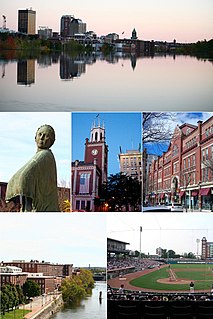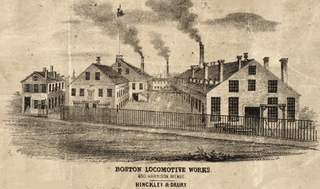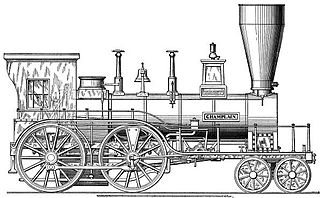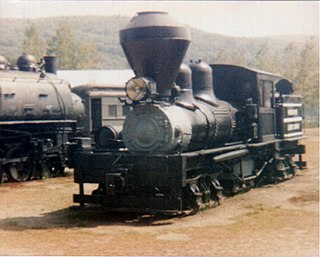
Manchester is a city in Hillsborough County in southern New Hampshire, United States. It is the most populous city in northern New England. As of the 2020 census, the city had a population of 115,644.

The American Locomotive Company was an American manufacturer of locomotives, diesel generators, steel, and tanks that operated from 1901 to 1969.

Orenstein & Koppel was a major German engineering company specialising in railway vehicles, escalators, and heavy equipment. It was founded on April 1, 1876 in Berlin by Benno Orenstein and Arthur Koppel.

Under the Whyte notation for the classification of steam locomotives, 2-6-0 represents the wheel arrangement of two leading wheels on one axle, usually in a leading truck, six powered and coupled driving wheels on three axles and no trailing wheels. This arrangement is commonly called a Mogul.

Aretas Blood was an American businessman from Vermont. He played an important role in the manufacture of early American railroad steam locomotives.

Hinkley Locomotive Works was a steam locomotive manufacturer based in Boston, Massachusetts in the 19th century.
Beyer, Peacock and Company was an English railway locomotive manufacturer with a factory in Openshaw, Manchester. Founded by Charles Beyer, Richard Peacock and Henry Robertson, it traded from 1854 until 1966. The company exported locomotives, and machine tools to service them, throughout the world.

Ezekiel Albert Straw was an American engineer, businessman, and politician from Manchester, New Hampshire. He was born in Salisbury, but moved with his family to Lowell, Massachusetts, where his father, James B. Straw, was employed at the Appleton Manufacturing Company. Ezekiel A. Straw, eldest of 7 children. A member of the first class of Lowell High School in 1831 before enrolling at Phillips Andover Academy in Andover, where he showed an aptitude for mathematics.

Manchester Locomotive Works was a manufacturing company located in Manchester, New Hampshire, that built steam locomotives and fire engines in the 19th century. The first locomotive the company built was for the Chicago, Burlington and Quincy Railroad in March 1855.
Robert Stephenson and Company was a locomotive manufacturing company founded in 1823 in Forth Street, Newcastle upon Tyne in England. It was the first company in the world created specifically to build railway engines.
Haigh Foundry was an ironworks and foundry in Haigh, Lancashire, which was notable for the manufacture of early steam locomotives.

The Amoskeag Manufacturing Company was a textile manufacturer which founded Manchester, New Hampshire, United States. From modest beginnings it grew throughout the 19th century into the largest cotton textile plant in the world. At its peak, Amoskeag had 17,000 employees and around 30 buildings.

The Taunton Locomotive Manufacturing Company was one of the earliest firms in the United States established especially for the manufacture of steam locomotives. Located in Taunton, Massachusetts, the company was organized in 1849 and incorporated the following year by William A. Crocker, Willard W. Fairbanks, William R. Lee and their associates. Their first engine, the Rough and Ready was delivered in May 1849.

Gorton Locomotive Works, known locally as Gorton Tank, was in West Gorton in Manchester, England and was completed in 1848 by the Sheffield, Ashton-under-Lyne and Manchester Railway.

Steamtown, U.S.A., was a steam locomotive museum that ran steam excursions out of North Walpole, New Hampshire, and Bellows Falls, Vermont, from the 1960s to 1983. The museum was founded by millionaire seafood industrialist F. Nelson Blount. The non-profit Steamtown Foundation took over operations following his death in 1967. Because of Vermont's air quality regulations restricting steam excursions, declining visitor attendance, and disputes over the use of track, some pieces of the collection were relocated to Scranton, Pennsylvania in the mid-1980s and the rest were auctioned off. After the move, Steamtown continued to operate in Scranton but failed to attract the expected 200,000–400,000 visitors. Within two years the tourist attraction was facing bankruptcy, and more pieces of the collection were sold to pay off debt.
The following is a timeline of the history of the city of Manchester, New Hampshire, United States.

Paul Rapsey Hodge was an English-American inventor and mechanical engineer. He invented technological improvements used by railroad companies. He also invented a device that ground wheat and other grains into flour that could then be used by bakers, as well as a machine that turned vegetable pulp into paper that could be used by printers. His innovations were useful to many industries. He was a writer of technical manuals in both the United States and England.

Alexander Bonner Latta was an American manufacturer and inventor. He specialized in engines that used steam for power. He designed railroad steam locomotives and directed the construction of the first such locomotive built west of the Alleghany Mountains. An unusual train locomotive design he innovated was one that had an additional set of cylinders that utilized steam exhaust for more power. He designed and constructed the first efficiently working steam fire engine to be routinely used as a part of a city's fire-fighting equipment. The fire engine was first adopted by Cincinnati, Boston, and New York City. He invented a self-propelled steam-engine fire engine.

George W. Stevens (1834-1897) was an American civil engineer and architect practicing in Manchester, New Hampshire, during the nineteenth century.
















